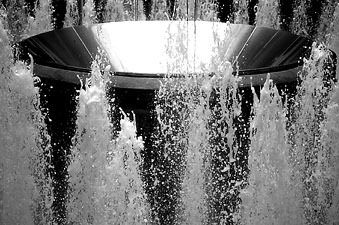 s
s
Here are two photo of the same fountain shot at different shutter speeds. The top picture was taken at a fairly fast speed, about 1/500th of a second and has frozen the drops of water in mid air.
The bottom photo was taken using a slower shutter speed, in other words the shutter was open for a longer time, which has allowed the fast moving water to blur a little. I don't remember what the shutter speed setting was for this shot but I would guess it was about 1/30th of a second because the camera was handheld and the bowl is quite sharp. At shutter speeds slower than 1/30th of a second it is quite difficult to hold the camera steady enough to get a sharp image. You need to use a tripod.
The static bowl of the fountain remains the same in both photos.
Whilst adjusting the shutter speed it is necessary to adjust the aperture in the opposite direction to ensure that the same amount of exposure is given to the film. If you use the 'shutter speed priority' setting on your camera this will be done automatically for you.
The shutter speed determines how long the film or sensor is exposed to light. Normally this is achieved by a mechanical shutter between the lens and the film or sensor which opens and closes for a time period determined by the shutter speed. For instance, a shutter speed of 1/125s will expose the sensor for 1/125th of a second. Electronic shutters act in a similar way by switching on the light sensitive photodiodes of the sensor for as long as is required by the shutter speed. Some digital cameras feature both electronic and mechanical shutters.Shutter speeds are expressed in fractions of seconds, typically as (approximate) multiples of 1/2, so that each higher shutter speed halves the exposure by halving the exposure time: 1/2s, 1/4s, 1/8s, 1/15s, 1/30s, 1/60s, 1/125s, 1/250s, 1/500s, 1/1000s, 1/2000s, 1/4000s, 1/8000s, etc. Long exposure shutter speeds are expressed in seconds, e.g. 8s, 4s, 2s, 1s. The optimal shutter speed depends on the situation. A useful rule of thumb is to shoot with a shutter speed above 1/(focal length) to avoid blurring due to camera shake. Below that speed a tripod or image stabilization is needed. If you want to “freeze” action, e.g. in sports photography, you will typically need shutter speeds of 1/250s or more. But not all action shots need high shutter speeds. For instance, keeping a moving car in the center of the viewfinder by panning your camera at the same speed of the car allows for lower shutter speeds and has the benefit of creating a background with a motion blur. Prosumer and professional cameras provide shutter priority exposure mode, allowing you to vary the shutter speed while keeping exposure constant
No comments:
Post a Comment